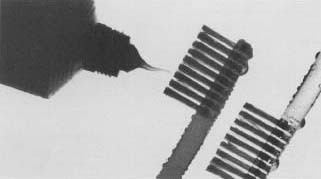Toothbrush and toothpaste
Early Brushes
The earliest toothbrushes were simply small sticks mashed at one end to increase their cleaning surface. Ancient Roman aristocrats employed special slaves to clean their teeth. Brushing the teeth was part of some ancient religious observances.
The bristle brush was probably invented by the Chinese and brought to Europe during the seventeenth century. French dentists, who were then the most advanced in Europe, advocated the use of toothbrushes in the seventeenth and early eighteenth centuries. Dentists urged pre-Revolutionary War Americans (before 1777) to use bristle toothbrushes.

Modern Brushes
Dr. Scott's "Electric Toothbrush" was marketed in 1880. Its manufacturer claimed the brush was "permanently charged with electro-magnetic current." The first real electric toothbrush was developed in Switzerland after World War II (1939-1945). This model, complete with electric cord, was introduced to the United States market in 1960 by the Squibb company under the name Broxodent. General Electric followed in 1961 with its rechargeable cordless model. Although it seemed an odd idea to many people at the time, the electric toothbrush was an immediate success.
Toothpaste
Like toothbrushes, compounds for cleaning teeth (and freshening breath) have been used since ancient times. Early Egyptian, Chinese, Greek, and Roman writings describe numerous mixtures for both pastes and powders. The more appetizing ingredients included powdered fruit, burnt shells, talc, honey, ground shells, and dried flowers. The less appetizing ingredients included mice, the head of a hare, lizard livers, and urine. Powder and paste formulas continued to multiply through the Middle Ages. Unfortunately, many of these recipes used ingredients that eroded (wore down) or abraded (nicked) the non-replaceable tooth enamel.
Modern toothpastes began to appear in the 1800s. Soap was added to tooth cleaners in 1824. Chalk was popularized by John Harris in the 1850s. Dr. Washington W. Sheffield, a Connecticut dentist, put his popular "Dr. Sheffield's Creme Dentifrice" in its collapsible tube on the market in 1892.
The toothpaste tube reigned supreme until 1984. Then the pump dispenser, which had originated in Europe, was introduced to the U.S. market. Fluoride, a chemical to fight tooth decay, was added to toothpaste in 1956, when Proctor & Gamble launched Crest toothpaste.
But very small about Chinese brushes...